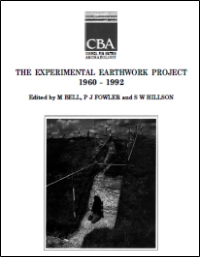CBA Research Reports
Council for British Archaeology, 2000. (updated 2020) https://doi.org/10.5284/1000332. How to cite using this DOI
Data copyright © Council for British Archaeology unless otherwise stated
This work is licensed under the ADS Terms of Use and Access.
Primary contact
Council for British Archaeology
92 Micklegate
York
YO1 6JX
UK
Tel: 01904 671417
Resource identifiers
- ADS Collection: 281
- DOI:https://doi.org/10.5284/1000332
- How to cite using this DOI
The Experimental Earthwork Project: 1960-1992
Edited by M.Bell, P.J.Fowler and S.W.Hillson
CBA Research Report No 100 (1996)
ISBN 1 872414 64 8
Abstract

This monograph reports on, provides a synthesis of, and assesses the results from the first 32 years of the Experimental Earthwork Project.
Contents
- Title pages - Table of contents (pp i-viii)
- List of figures (pp ix-vix)
- List of tables (pp xv-xvi)
- List of contributors' names and addresses (pp xvi-xviii)
- Summaries, English, French, German (pp xix-xxi)
- Acknowledgements (pp xxii-xxiii)
- Preface (pp xxiv-xxvi)
- Introduction by P.Fowler and G.Swanton (pp 1-7)
- Nature of the experiment (pp 1-3)
- Nature of this report (pp 4)
- Editorial notes: (a) authorship, (b) mensuration (pp 4-5)
- Organization and personnel (pp 5-7)
- Background, Overton by P.Fowler and G.Swanton (pp 8-12)
- Introduction (pp 8)
- 1960-64: The historical background (pp 8)
- Summary of results 1960-7(pp 8-10)
- The photographic record (pp 10)
- The setting (pp 10-11)
- The weather (pp 11-12)
- The coin experiment (pp 12)
- The vegetation of the Overton Site 1969-92 by J.H.Hemsley (pp 13-26)
- Editorial note (pp 13)
- Vegetation survey 1984 (pp 13-19)
- Vegetation survey 1992 (pp 19-24)
- Note on the recording method (pp 24-25)
- Exemplars from the Project Archive (pp 25-26)
- The 1968 Overton excavation (8th year) by P.Fowler (pp 27-33)
- Introduction (pp 27-28)
- The bank and the berm (pp 28-32)
- The ditch (pp 32-33)
- The 1976 Overton excavation (16th year) by P.Fowler (pp 34-42)
- Introduction (pp 34-35)
- Appendix: a modern burial (pp 35)
- The bank (pp 35-39)
- The ditch (pp 39)
- The geomorphology of the ditch infillBy K.Crabtree (pp 39-42)
- Introduction (pp 34-35)
- Artefacts and buried materials from the Overton Down, 1968 and 1976 excavations by P.Fowler with major contributions by G.W.Dimbleby and S.Limbrey (pp 43-65)
- Introduction (pp 43)
- Lycopodium spores by G.W.Dimbleby (pp 43-45)
- Ceramics and their experimental roles in the Overton Down Earthwork (pp 45-46)
- Pottery discs, potsherd and flints (pp 46-52)
- The buried materials (pp 52-65)
- Overton Down 1992 excavation (32nd year) by M.Bell (pp 66-89)
- Introduction (pp 66)
- The research design (pp 66-67)
- Methodology (pp 67-70)
- Changes to the ditch (pp 70-73)
- The bank (pp 73-78)
- Placed objects (pp 78-80)
- Buried materials in the chalk environment (pp 80-85)
- Buried materials in the turf environment (pp 85-89)
- Soils and sediments from the Overton Down 1992 section (pp 90-126)
- Introduction (pp 90)
- Particle size analysis of ditch sediments by K.Crabtree (pp 90-93)
- Characterization of ditch sediments by J.Crowther (pp 93-95)
- Soil micromorphology by R.Macphail and G.M.Cruise (pp 95-107)
- Soil chemistry by J.Crowther (pp 107-118)
- Magnetic susceptibility survey by A.J.Clark (pp 118-121)
- Amino acid studies by J.Beavis and G.MacLeod (pp 121-126)
- Biological evidence from the old land surface and ditch in the Overton 1992 section (pp 127-146)
- Introduction (pp 127)
- Lycopodium spores by K.Crabtree(pp 127-129)
- Pollen analysis, old land surface by K.Crabtree (pp 129-131)
- Microscopic charcoal by J.Moore (pp 131-134)
- Seed flora studies by W.Carruthers and V.Straker (pp 134-138)
- Seed persistence and plant decomposition after soil burial for 32 years by G.A.F.Hendry,S.R.Band and S.Johnson (pp 138-140)
- Land molluscs by M.Bell and S.Johnson (pp 140-142)
- Modern molluscs by A.Rouse (pp 142-146)
- Buried materials from the Overton Down 1992 excavation (pp 147-177)
- Field recovery and storage of teh buried materials by R.Janaway (pp 147-148)
- Moisture content and pH within the earthworkR.Janaway and P.Maclean (pp 148)
- Microbiological report by J.Kelley and P.Wiltshire(pp 148-155)
- Micromorphological aspects of wood decay by R.A.Blanchette(pp 155-160)
- Textiles by R.Janaway (pp 160-168)
- The textiles and their fibres by M.L.Ryder (pp 168-174)
- Infrared analysis of the textile samplesby S.Hardman (pp 174-176)
- Leather samples by G.Edwards (pp 176-177)
- Studies of the buried bone from the Overton 1992 excavation (pp 178-200)
- Introduction (pp 178)
- Surface modification of bone by M.Armour-Chelu and P.Andrews (pp 178-185)
- A scanning electron microscope study of bone,cement,dentine and enamel by S.Hillson and S.Bond (pp 185-195)
- Phosphate migration around buried bones by J.Crowther (pp 195-196)
- A note on work-in-progress on the DNA content and other diagenetic aspects of Overton Down bone by R.E.M.Hedges,M.B.Richards and B.C.Sykes (pp 196-199)
- Chemical structure of DNA in bone form Overton Down by T.A.Brown,K.O'Donoghue and K.A.Brown (pp 199-200)
- The Experimental Earthwork on Modern Bog, Wareham 1973 (10th year) to 1990 (27th year)by S.W.Hillson (pp 201-224)
- Introduction (pp 201)
- Current vegetation and management of the siteby J.Hemsley (pp 201-205)
- Excavation programme (pp 205)
- The development of the ditch section (pp 205-206)
- Geomorphology of the ditch by K.Crabtree (pp 206-208)
- The development of the bank (pp 208-216)
- The changing bank stratigraphy (pp 208-209)
- Markers within the bank (pp 209-211)
- Buried soils within and under the bank (pp 211-214)
- Soil micromorphology by R.Macphail (pp 214-216)
- Archaeological applications of ditch and bank studies (pp 216-217)
- Buried materials (pp 217-223)
- Wool following a report by H.M.Appleyard (pp 217-218)
- Linen and rope (pp 218)
- Leather and hide (pp 218-221)
- Wood billetsby J.Hather (pp 221-222)
- Animal bone (pp 222)
- Cremated human bone and human blood (pp 222)
- Glass (pp 222)
- Fired clay (pp 222-223)
- Flints (pp 223)
- Halfpennies and steel discs (pp 223)
- Lycopodium spores (pp 223)
- Archaeological applications of the buried materials (pp 223)
- Suggestions for future planning (pp 224)
- Experimental domestic octagonal earthworksby P.J.Reynolds (pp 225-227)
- Discussion and conclusions by M.Bell (pp 228-246)
- Historical context (pp 228-230)
- Issues of timescale (pp 230-231)
- Vegetational history - Overton Down (pp 231-232)
- Comparison of vegetation history at Overton and Wareham (pp 232)
- The experiment's contribution to conservation issues (pp 232-233)
- Comparison of the buried soils and turf stacks (pp 233)
- Comparison of the banks (pp 233-234)
- Comparison of the ditches (pp 234-236)
- Earthworms and soil fauna (pp 236-237)
- Biological evidence (pp 237-238)
- The buried materials (pp 238-241)
- Comparison between the buried materials at Overton and Wareham (pp 241-242)
- Ongoing analysis (pp 242-243)
- Problems with the experiment (pp 243-244)
- Merits of the experiment (pp 244)
- Work study (pp 244)
- Experiment and the study of formation processes in archaeology (pp 244-246)
- Acknowledgements (pp 246)
- Introduction by P.Fowler and G.Swanton (pp 1-7)
- Bibliography (pp 247-258)
- Index by S.Vaughan (pp 259-267)
Download report
| The Experimental Earthwork Project: 1960-1992 (CBA Research Report 100) | 15 Mb |







